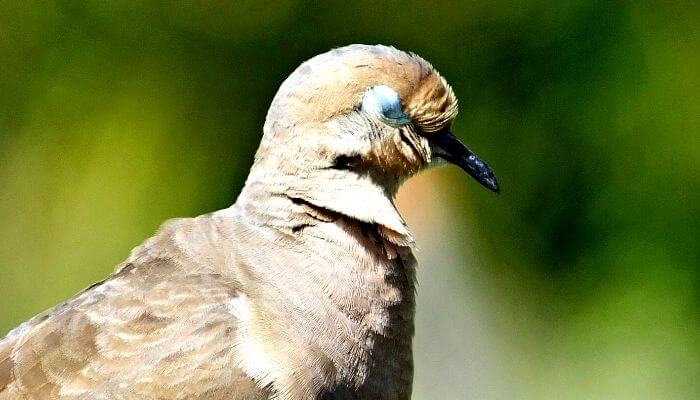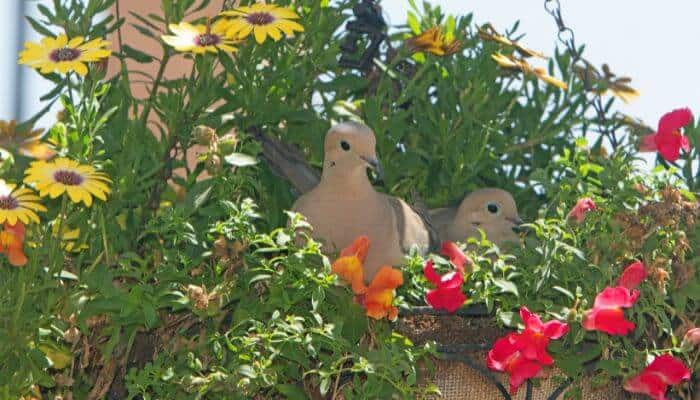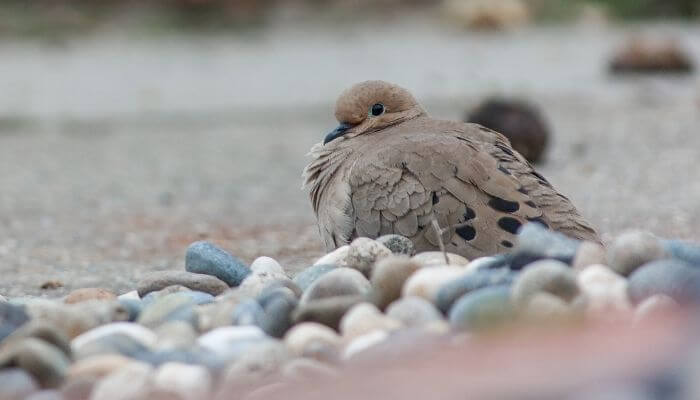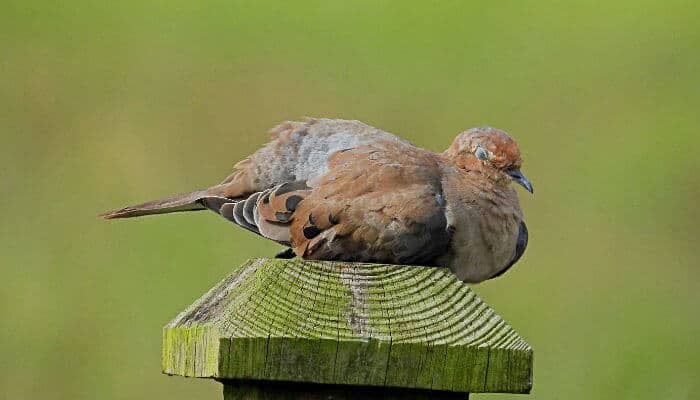The main choice of a place to sleep for a mourning dove is out of sight of predators. Their favorite places include nest boxes, chimneys, trees on the inside edges of fields and dead trees.
The mourning dove is one of the most populous birds of North America.

In fact, their abundance in urban areas has led to people being complacent and not truly appreciating just how pretty they are!
Their feather composition ranges from smooth gray to violet to turquoise and the mourning dove is a very beautiful bird when viewed up close.
Roosting vs Nesting
These two terms are not generally interchangeable. Many bird species, including the mourning dove, do not sleep in their nests.
- Roosting: resting and sleeping
- Nesting: laying eggs and raising chicks
The parent may spend the night in the nest during the incubation period or on particularly chilly nights when the chicks are still young and need protection from the cold.
Where Do Mourning Doves Roost?
The secret to where mourning doves like to sleep is based primarily on their survival instincts.
They always seek out a spot to rest where they do not think that any predators will be able to see them. After all, who can rest in a place where they can sense that danger is nearby?

There are plenty of different locations in both rural and urban areas that fit the bill for this kind of hiding place, and these include:
- Chimneys on top of homes.
- Nest boxes that bird lovers have actively put outside to attract birds of all sorts to their gardens.
- Dead trees have convenient holes and hollows within them that larger predators are unable to reach or fit into.
- At the top of healthy trees, usually located on the more protected and crowded inside edges of fields.
- Inside hanging baskets.
- They’ll even roost on power lines.

The mourning dove has three criteria when choosing a roosting site:
- Security – A safe sleeping site is a survival issue. Mourning doves want to sleep as far away from predators as possible. If distance cannot be achieved, then the next best option is somewhere where they are well hidden. They will also sleep as close to the nesting site as possible during the breeding season.
- Nutrition – As a granivorous bird, it makes sense that mourning doves are regularly found on or near farming sites. Seeds make up an awfully large proportion of what a pigeon eats and farms usually have some form of water source, so they are attractive habitats. Rows of trees that form field and farm boundaries also provide shelter from the elements.
- Warmth – This is a big consideration in winter particularly because mourning doves live in some harsh climates with cold nights. It is not unusual for this bird species to have bad feet because they lose toenails and get injuries due to frostbite.
The Sleeping Habits of Mourning Doves
Probably more interesting than where mourning doves sleep is their sleeping habits:
Sleeping Position
Unlike the majority of other bird species, the mourning dove does not place its head behind its shoulder feathers while it is sleeping.
Instead, they rest their heads between their shoulders.

The reason for this is that it enables them to reach a maximum level of warmth because it lets them keep their heads as close to the main heat of their bodies as possible.
One Eye Open
Something particularly interesting about the mourning dove is that they have the ability to sleep with one eye open!
As you might imagine, this is to protect themselves from the threat of predators in their vicinity.
Unlike us humans, mourning doves are able to send information to only one side of their brain if they want to, which enables them to rest while also staying aware in case of predator threats.
This ‘half and half’ style of rest results in a lower quality of sleep for the mourning dove because only 50% of their mind has been allowed to shut down, but it remains an effective defense mechanism that is vital for survival in the wild.
Perching
Along with the ability to keep one eye open during sleep, mourning doves can also sleep whilst standing up if they have to!
If they feel safe enough on a particular high branch on an isolated tree, for example, they can enter into a state of sleep whilst still programming their claws to clutch to their perch so they can remain in place without falling.
Mourning doves are also sociable sleepers. They often roost in large flocks.
